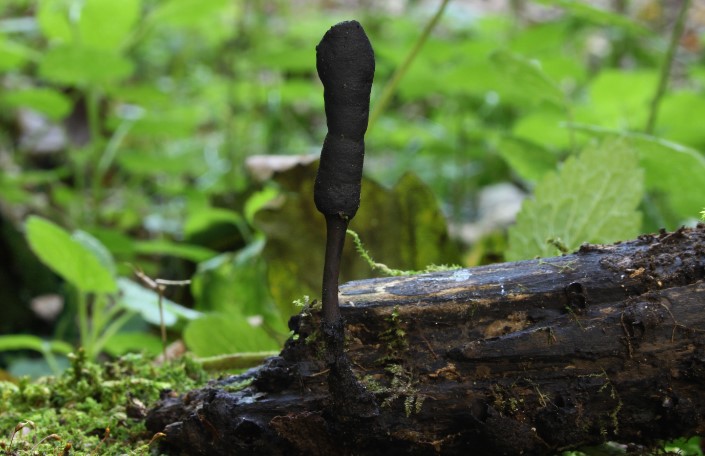Xylaria longipes appear throughout the year on beech and sycamore stumps and occasionally on other buried hardwoods. Dead Moll’s Fingers usually arise in tufts like the fingers of a dead hand, although the narrow stems do rather spoil the illusion. The stromata comprise white infertile finger-like forms with a black coating containing the flasks within which the asci (singular ascus) produce their spores. Known as ‘flask fungi’, these small black compound fruitbodies are difficult to spot in dark woodlands.
This species is found on a variety of hardwoods and is known for its ability to decompose dead wood. Although not as well known as some other fungi species, Xylaria longipes plays an important role in the ecosystem by breaking down dead organic matter and releasing nutrients back into the soil.

Xylaria longipes were first scientifically described by Theodor Rudolph Joseph Nitschke in 1867. Xylosphaera longipes (Nitschke) Dennis. Nomenclature in biology is an ever-evolving field, and new names can sometimes be added or changed over time as more information becomes available. However, the currently accepted scientific name for this species is Xylaria longipes.
The specific epithet “longipes” is derived from Latin and means “with long feet”, referring to the long stalks below the fertile club-like structures of the stromata. The fruiting bodies of Xylaria longipes are finger-like and vary in height and diameter, and the surface of the fruiting bodies change in appearance as they mature, from initially pale to eventually dark and slightly granulated. This species is an important component of forest ecosystems and is a valuable subject for scientific study and observation.
The communal fruitbody of Xylaria longipes is known as a stroma and is composed of hard white flesh. Within the stroma are spore-producing cavities called perithecia, each with a small pore-like hole at the top. The spores produced by the asci inside the perithecia are released through these pores to the outside, where they are dispersed by wind or other environmental factors. The life cycle of Xylaria longipes is an important part of the decomposition process in forest ecosystems and contributes to the renewal of the nutrient cycle.
The ascospores produced within the asci of Xylaria longipes are dark brown, smooth, spindle or banana-shaped, and measure 12-16 x 5-7 μm. The asci themselves are typically 130-180 x 7-9 μm and contain 8 ascospores. These structures are an important part of the reproductive cycle of Xylaria longipes and play a role in the dispersal and distribution of this species in the environment. The precise anatomy and characteristics of Xylaria longipes and other fungi species provide valuable information for scientists studying the biology, ecology, and evolution of fungi.
Xylaria longipes, like other species in the genus Xylaria, are capable of both sexual and asexual reproduction. In addition to the ascospores produced in the asci, this fungus can also reproduce asexually through the production of conidiospores, which are smaller, smooth, and elliptical to obovoidal in shape. Conidiospores are produced mainly in the summer and autumn, while ascospores are produced in the autumn and early winter. This combination of reproductive modes allows Xylaria longipes to adapt to changing environmental conditions and to persist and spread in a variety of habitats.
Xylaria longipes are not considered edible and are not recommended for human consumption. While some fungi species are considered edible and are used as a food source, many other species, including Xylaria longipes, contain compounds that are toxic or otherwise harmful to humans and other animals. It is important to be able to accurately identify and distinguish edible fungi species from those that are toxic or inedible, as consuming the wrong species can result in serious health consequences. If you are interested in consuming fungi, it is best to consult a knowledgeable expert or reliable source for information and guidance.
Read More – The Dead Man’s Fingers







